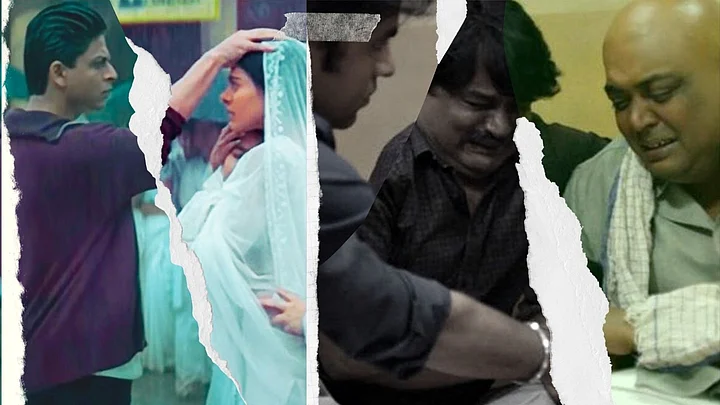(Note: The article contains spoilers)
Funeral scenes are quite common in Hindi cinema. Filmmakers have often tried to depict the excruciating beauty in grief. However, for years, funerals have been associated with grandeur and theatrics. There's nothing messy about them. Thankfully, there's some ray of hope with films like Ramprasad Ki Tehrvi, Pagglait and Panchayat. The latest season of Amazon Prime Video's Panchayat depicts a heart-wrenching funeral scene.
Let's take a look at what funerals were in Hindi films and shows to how they have transformed.
Theatrics in Death
Remember what happens when Bauji dies in Kabhi Khushi Kabhie Gham? The whole of Chandni Chowk turns up at the funeral, dressed in white! It suddenly starts raining, everyone has the SAME black umbrella, and Rahul (Shah Rukh Khan) turns up out of nowhere.
He is shocked to see Anjali's (Kajol) father is no more, and he reacts by instantly proposing marriage to her. In the same breath, they tie the knot while Anjali sobs away.
Rahul and Rohan's (Hrithik Roshan) grandmother's funeral is also the same grand affair. Was the crematorium specially set up for the Raichands?
The emotional scenes are so over-the-top that you barely feel for the characters.
The same goes for Hum Aapke Hai Koun... A grand set-up, where the family members can hardly be distinguished from one another. Even the guests have their starched clothes ready. It's an eyesore to watch such a scene which otherwise calls for tears.
A majority of the films from that time pretty much stuck to the same formula when it came to death. Even the make-up was on point while shedding tears.
Who Said Funerals Are Synonymous With White Clothes?
Crisp white clothes, a little bit (or tonnes) of makeup and an impeccably-designed set - this is what funerals in Hindi films and shows looked like for years. Panchayat 2 breaks this myth and how. The show ends on a very bleak note, wherein we see the deputy Pradhan Prahlad (played by Faisal Malik) lose his only child, who was in the Army.
The whole village of Phulera comes together to mourn the tragic demise of the young man. As they gather for the last rites, most of them wear their regular clothes. There’s no theatrics in the act.
The grief feels too real when Manju Devi (Neena Gupta) breaks down after hearing the news and Pradhanji (Raghubir Yadav) pours a bucketful of water on himself after returning from the crematorium. The neem leaves lying on the side are a reminder of how innumerable nauseating rituals perch on people during their most private moments. Panchayat 2 doesn’t overdo the tragedy, it uses little gestures to state the magnitude of the event.
'Ramprasad Ki Tehrvi' and The Circus During Funerals
Seema Pahwa’s directorial debut is a stunning commentary on the culture of grief. The film begins with Ram Prasad (Naseeruddin Shah) dying and the narrative unfolds over the days till his tehrvi. Ram Prasad’s six children, their spouses and kids have gathered in their ancestral home in Lucknow, and as the movie progresses it highlights the obsession with rituals in middle-class Hindu families, wherein the line between celebration and sombreness is blurred.
Lengthy arguments ensue about how kachoris should be cooked, three sister-in-laws complain about the fourth, there are fights when it comes to using the washroom, and one nephew even manages to flirt. One of the opening scenes features an uncle mocking the older sons for reaching Lucknow later than him. Just inches away from the corpse, the men argue about their arrival times, emphasising on how they dropped everything to attend their own father’s funeral.
In another scene, when guests arrive to pay their respects, they just have one question to ask - “How did it happen?” The grieving wife (Supriya Pathak) keeps repeating the same sequence of events. The scene is not made for laughs, but it brings forth the awkwardness of a situation like this.
At one point, Ammaji looks at her family and wonders whether she can recognise them at all. She says mournfully: Aaj jab sab saath hain toh bohot akelapan lag raha hai.
There are no villains in Ramprasad Ki Tehrvi; as the layers peel, we see how flawed all the characters are and how each of them is dealing with their own demons.
If there’s any villain in the movie, it’s the theatrics that the society expects us to participate in when someone passes and how privacy just becomes a state of mind.
Pagglait - Not All Widows Are Tragic Figures
Most Hindi films have depicted widows as tragic figures. Pagglait turns the tables and shows a young widow who is neither miserable nor over-the-top. Umesh Bist’s heroine Sandhya Giri (Sanya Malhotra) loses her husband Astik soon after their marriage. Sandhya isn't regressive, nor is she super liberal. Her MA degree helped her parents 'secure' a husband with a handsome salary for her. Sandhya went with the flow, dutifully following the instructions laid out for her. So when tragedy strikes, she is at a loss trying to figure out why she feels no sadness.
Pagglait covers the time between Astik's cremation and the tehrvi, and gives Sandhya time to figure out who she really is. Not for a moment does Bist make Sandhya stand out. She is a regular woman who has been conditioned to be submissive, and who has a realisation in the saddest of circumstances. That's Pagglait's win. It brings out the extraordinariness through the mundane, making us reflect that each of us feel and react differently to grief.
It's very difficult to depict grief on screen with all heart. From the regressive customs and beliefs involved in the last rites to the gossip and tensions that continue beyond the mourning among the surviving family, there's a lot to grapple with when faced with a dear one's death. So it's only fit that cinema portrays funerals in all its messiness.
